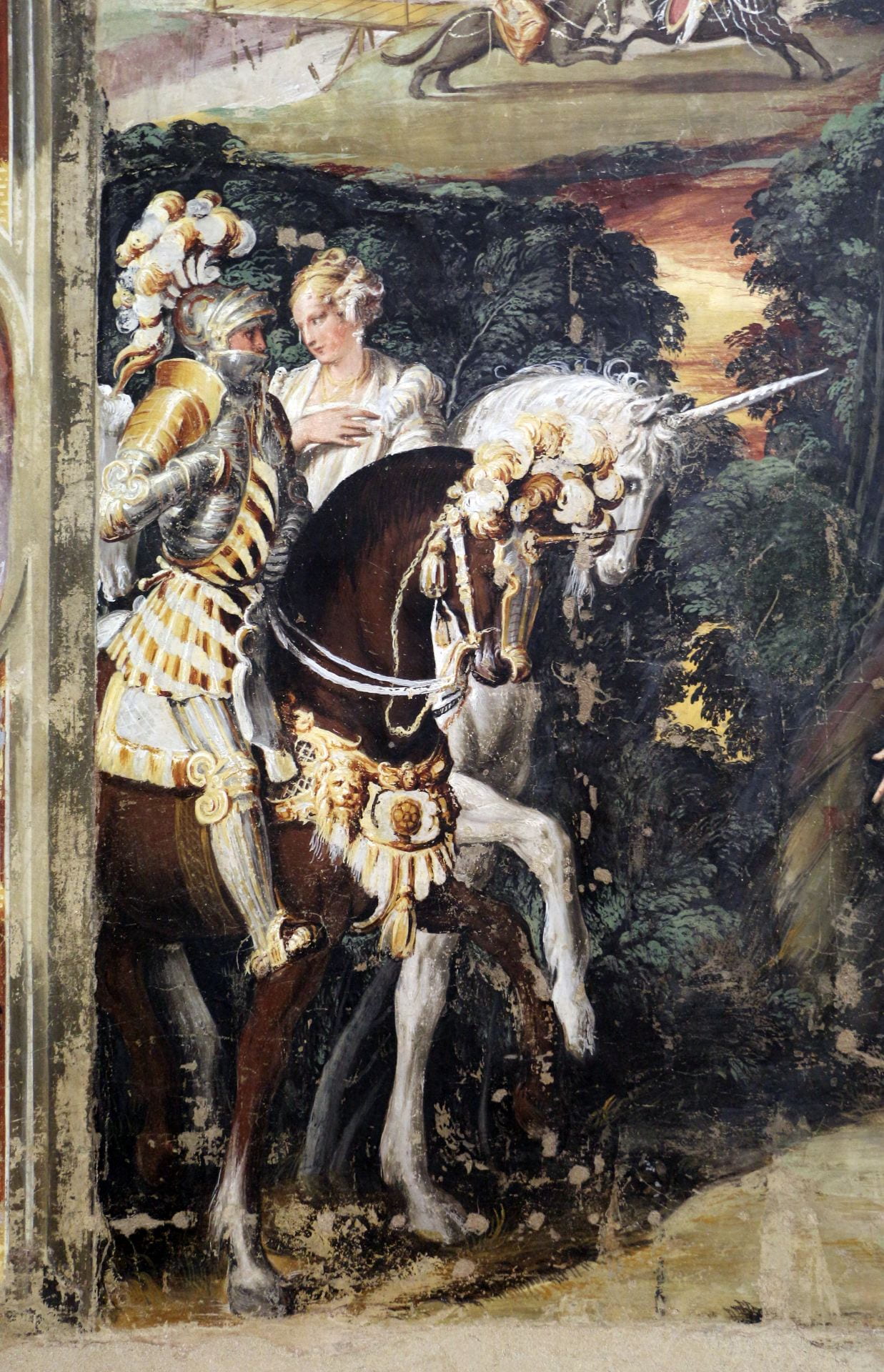Italy
Composed: 1506-1532 CE
Published: 1516; 1521; 1532
Lodovico Ariosto,
Orlando Furioso
The first edition of the poem in 40 canti was completed in 1515 and appeared in print in 1516. Ariosto continued to work on the poem throughout his lifetime, producing a second edition in 1521 that contained relatively minor revisions and a definitive third edition in 1532 that included four additional episodes inserted within the poem, bringing the number of canti from 40 to 46.
The epic war between Agramante and Charlemagne–which began in the Innamorato as a case of aviditas dominationis in which the king of Biserta exemplified an overreaching ruler destined to lose his kingdom in a reckless attempt to acquire something he did not possess–increasingly takes on the connotations of a holy war. The African ruler thus comes to represent an enemy of the Christian faith who must be either converted or annihilated. The knight who plays a principal role in this ideological shift toward a Crusading ethos is Prince Astolfo of England, who, after a purgatorial experience in the Indian Ocean, slowly develops into a miles Christi, as evidenced by his worship at the Church of the Holy Sepulcher in Jerusalem, his charitable mission on behalf of Senapo (Prester John) in Ethiopia, his retrieval of Orlando’s wits in a phial on the moon under the guidance of St John, and finally his participation in the destruction of Agramante’s North African kingdom under God’s direction.
Once Orlando has been cured of his insanity by inhaling his wits, the rehabilitated paladin makes amends for his sinful behavior by using his regained faculties to further the Christian cause. This marks the end of Orlando’s parenthesis as would-be Arthurian lover-turned-madman and a return to his original identity as a dutiful paladin. In the final phase of the war both Orlando and Astolfo take on the role of religious as well as military leaders (40.11).
Additionally, Senapo puts a vast army at Astolfo’s disposal, thus enabling the fulfillment of one of the most persistent fantasies of western Europe: that of finding a powerful Christian ally in the heart of Africa to help defeat the Muslims on a grand scale. The combined forces of Charlemagne and Senapo, under the leadership of Orlando and Astolfo, undertake the sack of Biserta (40.33–4), which is described at great length and with a particularly harrowing description that evokes the conquest of Jerusalem in early accounts of the First Crusade. Even though at this point all is already lost for the Saracens, the definitive outcome is decided by a three-on-three duel on the island of Lipadusa (Lampedusa).
The poem’s final, post-war episode combines the epic, romance, and dynastic themes by positing the return of King Rodomonte of Algeria to challenge Ruggiero on the day of his wedding to Bradamante. Ruggiero’s victory over Rodomonte directly recalls that of Aeneas over Turnus in the Aeneid, and leaves readers with the image of Rodomonte’s soul indignantly descending to the otherworld rather than with the festive celebration of requited love.
The four episodes added in the 1532 edition are inserted within the frame of the existing narrative. These added adventures all take place in an extended Europe: Olimpia and Bireno in the British Isles, the Rocca di Tristano in France, Marganorre in an unnamed site apparently not far from Arles (Provence), and Ruggiero and Leone between Paris and the Balkans.
The Ruggiero and Leone story not only provides the final additional episode in Ariosto’s expanded poem, but it also marks a new trajectory for the character of Ruggiero. The episode consists of a trial in which Ruggiero is required by the rules of courtesy to be willing to give up what he values most in the world: his beloved Bradamante. Due to a series of narrative twists, however, when Ruggiero relinquishes Bradamante to the Byzantine prince Leone, the latter, compelled by the laws of reciprocity, not only cedes her back to Ruggiero, but unconditionally offers his person and his state as a resource: “mai trovar satollo / non mi potrai, che me e lo stato mio / spender tu possa ad ogni tuo disio” [“Draw freely upon me and upon my state: / you will never exhaust your credit”] (45.83). Since Ruggiero had in the meantime been proclaimed king of Bulgaria by its inhabitants, Leone’s courtesy and friendship guarantee peace between two previously warring nations.
The pattern of reciprocal other-regarding actions leading to friendship illustrated in this episode contrasts starkly with Ariosto’s reflection in the first edition that even his patrons’ closest friends had acted like enemies due to political circumstance: “quanti n’havete, o glorïosi nati / d’Hercole invitto, a questi dì veduto / che vi son stati e son di cor amici, / e ne li effetti poi come nemici!” [“How many, oh glorious ones born of invincible Hercules, have you seen in our day that were and still are your close friends, but who in their deeds are like enemies”] (35.5A). Despite the subsequent removal of this reflection, perhaps we should not take lightly the fact that Ariosto ends all three editions with the Latin motto “pro bono malum” – an apparent warning to readers not to expect anything other than evil in return for the good they may do for others.
Columbia University
Resources
The Orlando Furioso Atlas: an interactive digital mapping project that aims to represent the world of the Orlando Furioso in cartographic terms. See: Daniel Leisawitz, “The Orlando Furioso Atlas: A Digital-Cartographic Study of a Sixteenth-Century Epic.” Italian Culture 37.2 (September 2019): 144-149.
Galassia Ariosto: Un archivio digitale dei poemi narrativi illustrati tra Cinque e Seicento
The digital archive L’Orlando furioso e la sua tradizione in immagini allows users to examine and compare illustrations and paratextual apparatus from the principal sixteenth-century editions of the Furioso and includes an extensive section on artwork inspired by the poem
eBOIARDO (Epics of Boiardo and Other Italian Authors: A Research Database Online): contains videos of theatrical adaptations, Sicilian puppet theater, and Maggio epico performances, as well as materials and links related to musical adaptations, artistic representations, and relevant world maps.
ADDilettante Ariosto Project: contains a detailed summary, chronology of the principal characters, and list of characters.
eBOIARDO: videos of performances based on episodes of this epic poem
The following questions are geared toward a discussion of Ariosto’s Orlando Furioso in the context of the upper-level undergraduate course Nobility and Civility: East and West (Columbia University global core).* A syllabus of the course can be found here.
Ludovico Ariosto, Orlando Furioso/The Frenzy of Orlando, trans. Barbara Reynolds, 2 vols. (NY: Penguin, 1975). While Paris is under attack, Orlando sneaks out in search of Angelica (8.68-83 and 9.1-7, pp. 280-287); Orlando goes mad when he discovers Angelica loves a foot soldier (23.100-136, pp. 718-727); Orlando recovers his wits with a little help from God and his friends (39.44-61, pp. 444-448).
When Ariosto picks up the threads of Boiardo’s unfinished Orlando Innamorato, he reveals that Angelica escaped from the Christian camp when Paris was attacked by the north African king Agramante and his allies. He further imagines that Orlando regrets leaving Angelica is another’s care. Does Orlando’s love for Angelica, expressed in his lament and manner of departure from Paris, make him more or less noble? How can he be compared to Lancelot at the opening of The Knight of the Cart?
What are the consequences of Orlando’s madness, both for himself and the world around him? If love overpowers everyone, especially those who are most proud, as Boiardo had warned at the outset of his earlier poem, are all humans susceptible to madness upon finding our amorous illusions burst? Was Orlando at any point (in the passages we read) in control of his emotions and actions?
Given that Orlando regains his sanity only when his friends tie him down and force him to inhale his wits in a phial, is Ariosto emphasizing more the knight’s utter inability to recover on his own or the value of his tenacious friends who act for his sake even though he keeps knocking them out?
Jo Ann Cavallo (Columbia University)
*This two-semester course was designed through the Faculty Workshops for a Multi-Cultural Sequence in the Core Curriculum (Heyman Center for the Humanities, 2002-2009), directed by the late Wm. Theodore de Bary, at Columbia University.

